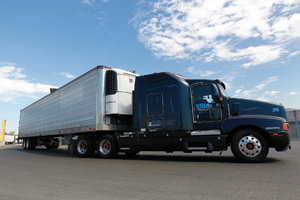Senior Reporter
CARB Touts ‘Most Promising’ Technologies That Could Cut GHG Output From Reefers

This story appears in the Aug. 24 print edition of Transport Topics.
Electric and hydrogen cell-powered transport refrigeration units are the “most promising” technologies that can be used to reduce reefer emissions over the next five to 10 years and beyond, according to California environmental regulators.
The California Air Resources Board’s new technology assessment does not indicate what might be the next TRU regulatory requirement for the state’s truckers, but it indicates that the most likely use of the conventional and advanced technologies would be by private fleets that operate locally and regionally.
“Range is a challenge,” said the report released earlier this month. “Longhaul carriers will not be good candidates for these technologies until publicly accessible refueling infrastructure is sufficiently available for Class 8 semi-trailers along transportation corridors.”
Grocery distribution and food service distribution fleets that return to base between routes may be candidates for these technologies when they are commercially available, the report noted.
Reefers are mostly powered with diesel fuel and installed on insulated cargo vans, railcars and shipping containers used to transport produce, meat, dairy products, beverages, film, prescription drugs and other temperature-sensitive goods, the assessment found.
CARB already has stringent TRU emissions-reduction requirements in place but continues to aggressively attempt to reduce emissions.
The technology assessment report was one of several the agency is conducting to work toward a goal of reducing greenhouse-gas emissions 40% by 2030 and 80% by 2050, and cutting diesel particulate matter emissions 85% by 2020, Rod Hill, a CARB air pollution specialist told Transport Topics.
Although some already are available, Hill said wide use of the promising TRU technologies won’t happen overnight.
“You start with the private fleets, and maybe over the course of time you start getting more infrastructure on the major transportation corridors,” Hill said. “At some point, you end up being mainstream where you’ve got enough out there that the longhaul guys can use them.”
Glen Kedzie, who manages Energy and Environmental Affairs for American Trucking Associations, said “CARB’s goal is to ultimately eliminate fossil fuels.”
ATA and California Trucking Association executives plan to meet with CARB officials since the agency is a nationwide leader in adopting regulatory requirements for greenhouse gas, nitrogen oxides and other emissions reductions.
“So truckers need to stay on top of their regulatory requirements,” Kedzie said.
There are approximately 7,000 truck TRUs based in California that emit 340 tons of nitrogen oxides and 13 tons of particulate matter each year, the assessment report said.
In addition, there are more than 20,000 trailer TRUs based in California and an additional 12,500 that are based outside of the state but operate there on any given day. They emit 4,043 tons of nitrogen oxides and 150 tons of particulate matter per year.
“Trucking is a very competitive industry and profit margins are very thin; so economics are a critical issue that makes widespread adoption of new technologies difficult,” the report said. “New technologies typically cost more.”
Mike Tunnell, ATA’s California-based director of environmental affairs, said CARB seems braced to switch from running diesel engines.
“Rather than run the TRU, CARB would like to see plugged-in electric standby function,” Tunnell said. “Then the question becomes where to go from there. Obviously, infrastructure is a huge question and cost.”
The cost of an original-equipment all-electric TRU for stationary cold storage is about $23,000. A conventional single-temperature trailer TRU is about $28,000, and it costs an additional $12,000 to convert to an all-electric unit for stationary cold storage, according to CARB estimates.
“All-electric TRs are commercialized and used to a much larger degree in Europe, driven by much higher fuel costs [fuel is not subsidized] and strict noise ordinances [all-electric TRs are much quieter than diesel-powered TRUs],” the report said. “Their use in the U.S. is growing but not yet widespread.”
Hill said that over the long term, hydrogen cell-powered reefers likely are the most viable future technologies for longhaul heavy trucks, but Tunnell said that the hydrogen technology likely won’t be ready for years.

